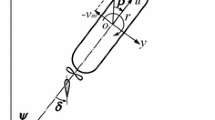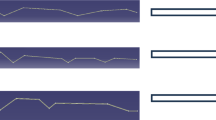Abstract
Supercavitating projectiles can achieve high speeds; however, this will pose technical challenges on their stability and flight performances. One of the most important issues which a high-speed underwater projectile (HSUP) deals with is the so-called planing force. In an ideal supercavitating flight scenario, the entire vehicle is considered to fly within the cavity walls. Nevertheless, in practice, disturbances can cause the vehicle to impact on the liquid–gas boundary. In such situations, the forces generated at the cavity boundary are referred to as the planning forces. The present paper discusses the in-flight dynamics of the HSUP. Equations of motion are developed for the projectile movements in the cavity while the tail impacts on the cavity wall. Dominant nonlinearities associated with planing forces are well thought-out in the modeling. Two available models and a new empirical model for prediction of the planning force are described. By using and combining these models, four methods are introduced and compared, through the simulation runs of supercavitated projectile flight, with two available experimental test cases.















Similar content being viewed by others
Abbreviations
- α :
-
Immersion angle
- α n :
-
Local angle of attack in the projectile nose
- A n :
-
Cavitator area
- \(C_{{A_{{0_{\text{c}} }} }}\) :
-
Axial force coefficient of the cavitator in zero angle of cavitator
- \(C_{{A_{{\delta_{\text{c}} }} }}\) :
-
Axial force coefficient due to change in angle of cavitator
- \(C_{{A_{{\delta_{\text{a}} }} }}\) :
-
Axial force coefficient due to change in aileron angle
- C D :
-
Drag coefficient of the cavitator
- C D0 :
-
Drag coefficient of the cavitator at zero incidence
- \(C_{{L\delta_{\text{a}} }}\) :
-
Rolling moment coefficient due to change in aileron angle
- \(C_{{M\delta_{\text{c}} }}\) :
-
Pitching moment coefficient due to change in angle of cavitator
- \(C_{{z\delta_{\text{c}} }}\) :
-
Normal force coefficient due to change in angle of cavitator
- D :
-
Reference length
- δ a :
-
Aileron angle
- δ c :
-
Cavitator angle
- \(F_{A}^{B}\) :
-
Hydrodynamic force in body coordinate
- \(F_{\text{g}}\) :
-
Gravitational force
- F n :
-
Cavitator force
- F p :
-
Planing force
- g :
-
Gravitational acceleration
- \(h^{\prime}\) :
-
Immersion depth
- (Ixx, Iyy, Izz):
-
Moments of inertia about each axis
- (Ixy, Iyz, Izx):
-
Products of inertia
- (L, M, N):
-
Component of hydrodynamic moments acting on supercavitating vehicle along each axis
- l :
-
Total length of projectile
- l max :
-
Maximum length of the cavity
- l ' :
-
Distance between the tail and the center of gravity of projectile
- \(M_{A}^{B}\) :
-
Hydrodynamic moment in body coordinate
- M p :
-
Planing moment
- M s :
-
Mass
- (p, q, r):
-
Angular rates
- P c :
-
Cavity pressure
- (φ, θ, ψ):
-
Euler angles
- P ∞ :
-
Ambient pressure
- q :
-
Dynamic pressure
- R :
-
Projectile radius
- R 1 :
-
Initial cavity radius
- R c :
-
Cavity radius
- \(\dot{R}_{c}\) :
-
Contraction rate of cavity radius
- ρ :
-
Density
- R max :
-
Maximum radius of the cavity
- R n :
-
Cavitator radius
- S :
-
Reference area
- σ :
-
Cavitation number
- t max :
-
Time for a cavity section to achieve R max
- τ :
-
Delay time
- (u, v, w):
-
Component of supercavitating vehicle velocity along each axis
- V :
-
Velocity magnitude
- (X, Y, Z):
-
Component of hydrodynamic forces acting on supercavitating vehicle along each axis
References
Kamada R (2005) Trajectory optimization strategies for supercavitating vehicles. Dissertation, Georgia Institute of Technology
Nguyen V, Balachandran B (2011) Supercavitating vehicles with noncylindrical, nonsymmetric cavities: dynamics and instabilities. J Comput Nonlinear Dyn 6:1–11
Lin G, Balachandran B, Abed E (2006) Nonlinear dynamics and control of supercavitating bodies. In: proceedings of the AIAA guidance, navigation, and control conference and exhibit, Keystone, CO, USA
Lee Q, Xue L, He Y (2008) Experimental study of ventilated supercavities with a dynamic pitching model. J Hydrodynam Ser B 20:456–460
Kulkarni SS, Pratap R (2000) Studies on the dynamics of a supercavitating projectile. Appl Math Model 24:113–129
Kirschner IN, Kring DC, Stokes AW et al (2002) Control strategies for supercavitating vehicles. J Vib Control 8:219–242
Choi J-Y, Ruzzene M, Bauchau OA (2004) Dynamic analysis of flexible supercavitating vehicles using modal-based elements. Simulation 80:619–633
Rand R, Pratap R, Ramani D et al (1997) Impact dynamics of a supercavitating underwater projectile. Proc DETC 79:14–17
Dzielski J, Kurdila A (2003) A benchmark control problem for supercavitating vehicles and an initial investigation of solutions. J Vib Control 9:791–804
Logvinovich G (1980) Some problems in planing surfaces. Trudy TsAGI 2052:3–12
Lindau J, Venkateswaran S, Kunz R, Merkle C (2001) Development of a fully-compressible multi-phase Reynolds-averaged Navier-Stokes model. AIAA Paper 2648:2001
Lindau JW, Kunz RF (2004) Advancement and application of multiphase CFD modeling to high speed supercavitating flows. DTIC document. Pennsylvania State University Park Applied Research Lab, Pennsylvania
Kirschner IN, Uhlman J, Varghese AN, Kuria IM (1995) Supercavitating projectiles in axisymmetric subsonic liquid flows. Asme Publ Fed 210:75–94
Nouri N, Eslamdoost A (2009) An iterative scheme for axisymmetric supercavitating flow. Proc Inst Mech Eng Part C J Mech Eng Sci 223:1869–1876
Kirschner IN, Rosenthal BJ, Uhlman JS (2003) Simplified dynamical systems analysis of supercavitating high-speed bodies. Cav03-OS-7-005. In: proceedings of the fifth international symposium on Cavitation (CAV2003), Osaka, Japan
Fine NE, Kinnas S (1993) A boundary element method for the analysis of the flow around 3-D cavitating hydrofoils. J Ship Res 37:213–224
Mokhtarzadeh H (2010) Supercavitating vehicle modeling and dynamics for control. Dissertation, University of Minnesota
Goel A (2005) Robust control of supercavitating vehicles in the presence of dynamic and uncertain cavity. Dissertation, University of Florida
Goel A (2002) Control strategies for supercavitating vehicles. Dissertation, University of Florida
Vanek B (2008) Control methods for high-speed supercavitation vehicles. Dissertation, University of Minnesota
Lv R, Yu K, Wei Y et al. (2010) Adaptive sliding mode controller design for a supercavitating vehicle. 3rd International symposium on systems and control in aeronautics and astronautics (ISSCAA). 885–889
Faruqi FA, Vu TL (2002) Mathematical models for a missile autopilot design. DTIC Document
Kirschner IN, Uhlman JS, Perkins JB (2006) Overview of high-speed supercavitating vehicle control. Guidance, navigation, and control conference and exhibit, Keystone, Colorado : American Institute of Aeronautics and Astronautics Inc (3100–3116)
Wosnik M, Arndt R (2009) Control experiments with a semi-axisymmetric supercavity and a supercavity-piercing fin. In: proceedings of the 7th international symposium on cavitation, Ann Arbor, Michigan, USA
Logvinovich G (1972) Hydrodynamics of free-boundary flows. U.S. Department of Commerce, Washington, DC, NASA translation NASA-TT-F-658
Vlasenko YD (2003) Experimental investigation of supercavitation flow regimes at subsonic and transonic speeds. Fifth International Symposium on Cavitation, Osaka, Japan
Zhang X, Wei Y, Zhang J et al (2007) Experimental research on the shape characters of natural and ventilated supercavitation. J Hydrodyn Ser B 19:564–571
Guo Z, Zhang W, Wang C (2012) Experimental and theoretical study on the high-speed horizontal water entry behaviors of cylindrical projectiles. J Hydrodyn Ser B 24:217–225
Zhang W, Guo Z, Xiao X, Wang C (2011) Experimental investigations on behaviors of projectile high-speed water entry. Explos Shock Waves 6:005
Mao X (2010) Nonlinear robust control design for a high-speed supercavitating vehicle. Dissertation, The Pennsylvania State University
Cameron PJK (2009) An acoustic countermeasure to supercavitating torpedoes. Georgia Institute of Technology. Dissertation, Georgia Institute of Technology
Yen T, Morabito M, Imas L et al. (2011) Investigation of cylinder planing on a flat free surface. 11th international conference on fast sea transportation FAST 2011, Honolulu, Hawaii, USA
Truscott TT (2009) Cavity dynamics of water entry for spheres and ballistic projectiles. Dissertation, Massachusetts Institute of Technology
Yuri F. Zhuravlev ANV, Shulman NA (2012) Cavity at body entry into water. In: proceedings of the 8th international symposium on cavitation, 13–16 August, Singapore
Author information
Authors and Affiliations
Corresponding author
Additional information
Technical Editor: Marcelo A. Savi.
Rights and permissions
About this article
Cite this article
Mirzaei, M., Alishahi, M.M. & Eghtesad, M. High-speed underwater projectiles modeling: a new empirical approach. J Braz. Soc. Mech. Sci. Eng. 37, 613–626 (2015). https://doi.org/10.1007/s40430-014-0190-7
Received:
Accepted:
Published:
Issue Date:
DOI: https://doi.org/10.1007/s40430-014-0190-7




